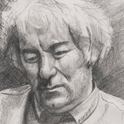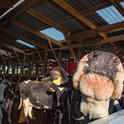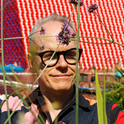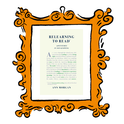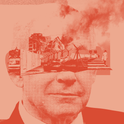David Attenborough’s Frozen Planet II, recently broadcast on BBC One, is his 139th series for the BBC as a producer, writer, presenter or narrator. And there’s more to come. Next year will see the arrival of Wild Isles, billed as “an eye-opening celebration of British and Irish wildlife” and narrated by Attenborough. Since 2005, BBC viewers have come to know British wildlife through Springwatch—a chatty, digestible, familiar programme, very much the soap opera to the prestige drama of Frozen Planet. It will be interesting to see how different our landscapes will seem once the elite corps of the BBC Natural History Unit (NHU) helicopters onto our fells and downs, toting drones, low-light cameras, macro lenses and motion-triggered time-lapse tech. Perhaps Wild Isles will feel like a sitcom on the big screen: the same characters, but better lit, in nicer locations and with the timing just that little bit off.
What Wild Isles is sure to have in common with Springwatch is a focus on individual emotive stories. Attenborough’s great early works—Life on Earth (1979), The Living Planet (1984)—were grand unfolding narratives of geological change and evolution; but later programmes make the animals the stars. “Storytelling took a huge shift in Planet Earth II [from 2016], being character-led, emotionally engaging and intimately shot,” says the conservation writer and filmmaker Mary Colwell, who has worked with the NHU for many years. “No longer was it the ‘voice of God’, but the audience immersed in the motivation and jeopardies of the characters.”
Think of Planet Earth II’s hatchling iguanas being pursued by a pack of Galápagos racer snakes, or the glass frog protecting his eggs from predatory wasps in the Costa Rican rainforest. As storytelling, it’s marvellously effective as well as being technically and visually jaw-dropping. But nature is mostly not made up of heart-warming stories but of very short, very bleak ones. Usually, the tiny turtle is unlikely to make it to the water’s edge. This is what Darwin called “the clumsy, wasteful, blundering low & horridly cruel works of nature”—the slow-grinding mill of evolution that has over many millennia turned out every variety of bird, mammal, plant, insect, sponge, fungus and protist. Evolution is the foundational narrative without which nothing makes much sense. It’s also a horrible way to make wonderful things. Billions of offspring are born into a system that requires nearly all of them to die pretty much right away. The small story, in nature, is almost always a sad one.
Not that nature documentaries can’t tell sad stories; storytelling in television is just not built to put across the statistical reality. Personally, I am still haunted by the shoebill chick turfed out of its nest and left to starve in 2013’s Africa. Yet “reality” is a vexed question in this genre, one that goes beyond the odd media blow-up about “misleading” footage (such as the fuss over Frozen Planet’s polar bear births that had, in fact, been filmed in captivity). The advance of technology—the ability to show animals with an intimacy and clarity that verges on the uncanny—leaves some viewers feeling paradoxically remote from the action. Deep focus, long exposures, time lapse, slow-mo—these are not human ways of seeing the world. “What I am watching,” wrote Emma Marris in a critique of nature documentaries for the Atlantic, “is in some measurable way more beautiful than real life.”
What would a more realistic nature programme look like? I like the idea of a 45-minute BBC showcase of birds flying by just out of shot, far-off mammals captured on bleary camera phones, footage of what might be either a curious beetle or a bit of dirt on the lens—and happy viewers saying to one another, “yes, this is what wildlife really looks like.” Early nature programmes did offer something similar to what you might see through binoculars on safari or at the seashore: there’s a moment in Life on Earth where Attenborough has to say: “that dot is the head of a seal.”
But of course, there is no “right” way for nature to be seen. Every kind of animal perceives the world in its own way. The hyper-evolved eyes of our cameras see things ours can’t—but so what? That doesn’t make their images any less authentic. Even timelapse footage—plant stems writhing snake-like from the ground, flowers and fungi opening out like hands—is as “real” as anything else. Speed is just a question of perspective.
Some of the most advanced tech turns out footage with a remarkably vintage feel. The first episode of Frozen Planet II used “timelapse photography from space” to show the scale of glacial melting—an astounding feat of televisual engineering that recalled the animated geological diagrams of late-1970s Attenborough. In filming the rarest of animals in the most remote habitats—such as the snow leopards in Planet Earth II—motion-detecting trailcams gave us the retro treat of a fixed-position camera that showed animals turning their backs to us, and even disappearing off-screen.
There is another notable feature—in this case, an undoubted flaw—of the NHU universe: its lack of people. The Unit has in recent years moved to address long-standing concerns about its depictions of contrived wildernesses (as Marris notes, NHU head Julian Hector promised in 2021 to include humans and built environments in its future productions) but as long as Attenborough is around it’s still, I think, a viable subject for scrutiny, because Attenborough’s relationship with people—as a species and as a subject—is so intriguing.
The science writer Ed Yong has hypothesised that “Attenborough’s work gets more interesting the further he gets from humans.” This sits well with some of what we know about Attenborough’s view of the natural world. He has, as Marris points out, spoken many times of his nostalgic love for “untouched wilderness”, as well as made a number of poorly supported interventions on “overpopulation”. But his early work was notably human focused. During his collaboration with London zoo for Zoo Quest during the 1950s and 1960s, Attenborough recalls “the tribal people we met on our journeys began to figure with increasing prominence”. In the 1960s, he enrolled in a social anthropology course at the LSE, though curtailed his studies to take charge of BBC Two.
In those early series, and the books that accompanied them, the enduring imagery is not really of lemurs and Komodo dragons but of Pentecost land-divers hurling themselves from high platforms and Aboriginal Australians painting each other’s bodies.
In his 2002 memoir, Life on Air, Attenborough recalls his early ideas for anthropological programmes but also his rationale for abandoning them: “Spying on one’s fellow human beings was an intolerable intrusion on their privacy… human beings are not, after all, the same as other animals, and television should not treat them as though they were.” Still, we don’t get the impression that the unpeopled savannahs, the “untouched” Edens created by the NHU, are that way solely because of Attenborough’s influence. My hunch is that they are simply giving viewers what they want. We want to look at wildebeest and gnu and buffalo; it’s more difficult for us to see the beauty in the human, and the human-made, or in other words to find one another beautiful.
Wild Isles will be interesting in this context. The NHU crew would be hard-pressed to find any pristine wildernesses on our squeezed little islands. Nature here is pushed to the margins. We’ve grown accustomed to seeing British wildlife as human-adjacent, occupying populated landscapes, in programmes like Countryfile. It will be nice to be reminded, cinematically, epically, with a sweeping Hollywood score, of what is magnificent in our local ecology—but it will be salutary to be shown people living alongside nature. I hope Attenborough will show us what is wild in the human as well as what is human in the wild.

